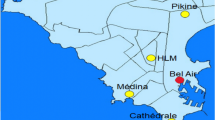Abstract
Nocturnal measurements of air temperature, relative humidity, temperatureinversion-layer thickness, water vapour path and visibility-through-fog, madeunder non-foggy and foggy conditions in winter over two seasons at Delhi,are analysed to study the decrease in both rate of cooling and temperature inversion-layer thickness during the course of nights followed by fog occurrence.In particular, the decrease in the rate of cooling, compared to that on non-foggynights, is explained as due to the greenhouse warming effect by a layer of excessive,near-saturated water vapour trapped in a temperature inversion. Next, the linearprogramming technique is employed to forecast the occurrence of fog, where thevisibility-through-fog is minimized through its linear regression equation with thepair of variables, mean air temperature and temperature decrease over one hour(measuring rate of cooling at two convenient hours) in the pre-midnight period.This technique provides feasible solutions that enables one to forecast the occurrenceof radiative fog.
Similar content being viewed by others
References
Brown, R.: 1987, 'Observations of the Structure of a Deep Fog', Meteorol. Mag. 116, 329–338.
Drieddonks, A. G. M. and Duynkerke, P. G.: 1989, 'Current Problems in the Stratocumulus-Topped Atmospheric Boundary Layer', Boundary-Layer Meteorol. 46, 275–303.
Duynkerke, P. G.: 1999, 'Turbulence, Radiation and Fog in Dutch Stable Boundary Layers', Boundary-Layer Meteorol. 90, 447–477.
Elsasser, W. M. and Culbertson, M. F.: 1960, Atmospheric Radiation Tables, Meteorological Monograph, Vol. IV, No. 23, Ch. 1, American Meteorological Society, Boston.
Falcone, Jr., V. J., Abreu, L. W., and Shettle, E. P.: 1979, Atmospheric Attenuation of Millimeter and Submillimeter Waves: Models and Computer Code, Report FGL-TR-79–0253, Air Force Geophysics Laboratory, Hanscom AFB, MA, 76 pp.
Fitzjarrald, D. R. and Lala, G. G.: 1989, 'Hudson Valley Fog Environments', J. Appl. Meteorol. 28, 1303–1328.
Glicksman, A. M.: 1963, An Introduction to Linear Programming and the Theory of Games, Part I, John Wiley and Sons, Inc., New York, 131 pp.
Iribarne, J. V. and Cho, H.-R.: 1980, Atmospheric Physics, D. Reidel Publishing Company, Dordrecht, Problem P5, p. 94.
Jiusto, J. E.: 1981, 'Fog Structure', in P. V. Hobbs and A. Deepak (eds.), Clouds, their Formation, Optical Properties, and Effects, Academic Press, New York, pp. 187–239.
Musson-Genon, L.: 1987, 'Numerical Simulation of a Fog Event with a One-Dimensional Boundary Layer Model', Mon. Wea. Rev. 115, 592–607.
Oke, T. R.: 1987, Boundary Layer Climates, Methuen, London, pp. 66–69.
Petterssen, S.: 1940, Weather Analysis and Forecasting, McGraw-Hill Book Company, Inc., New York, pp. 121–124.
Reudenbach, Ch. and Bendix, J.: 1998, 'Experiment with a Straightforward Model for the Spatial Forecast of Fog/Low Stratus Clearance Based on Multi-Source Data', Meteorol. Appl. 5, 205–216.
Roach, W. T., Brown, R., Caughey, S. J., Crease, B. A., and Slingo, A.: 1982, 'A Field Study of Nocturnal Stratocumulus. I: Mean Structure and Budgets', Quart. J. Roy. Meteorol. Soc. 108, 103–123.
Roach, W. T., Brown, R., Caughey, S. J., Garland, J. A., and Readings, C. J.: 1976, 'The Physics of Radiation Fog: I-A Field Study', Quart. J. Roy. Meteorol. Soc. 102, 313–333.
Sellers, W. D.: 1965, Physical Climatology, The University of Chicago Press, Chicago, pp. 44–45.
Turton, J. D. and Brown, R.: 1987, 'A Comparison of a Numerical Model of Radiation Fog with Detailed Observations', Quart. J. Roy. Meteorol. Soc. 113, 37–54.
Welch, R. M., Ravichandran, M. G., and Cox, S. K.: 1986, 'Prediction of Quasi-Periodic Oscillations in Radiation Fogs. Part I: Comparison of Simple Similarity Approaches', J. Atmos. Sci. 43, 633–651.
Author information
Authors and Affiliations
Rights and permissions
About this article
Cite this article
Pasricha, P.K., Gera, B.S., Shastri, S. et al. Role of the Water Vapour Greenhouse Effect in the Forecasting Of Fog Occurrence. Boundary-Layer Meteorology 107, 469–482 (2003). https://doi.org/10.1023/A:1022128800130
Issue Date:
DOI: https://doi.org/10.1023/A:1022128800130




